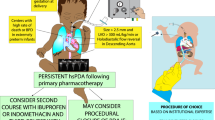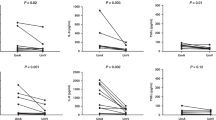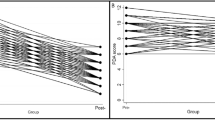Abstract
Objective
To estimate the effect of clinical chorioamnionitis on the risk of patent ductus arteriosus (PDA).
Study design
A secondary analysis of all deliveries >23 gestational weeks from the U.S. Consortium on Safe Labor (CSL) study. The primary exposure was a clinical diagnosis of chorioamnionitis, and the outcome was a diagnosis of PDA. Generalized estimating equations with estimated error variance for women with multiple deliveries were utilized. Models adjusted for age, race, region, delivery year, body mass index, infant sex, multiple gestation, mode of delivery, and antenatal corticosteroid exposure.
Results
Among 228,438 deliveries, a diagnosis of PDA was more frequent with chorioamnionitis exposure versus without (9.2% vs. 3.0%; OR: 3.25; 95% CI: 2.92–3.62). Chorioamnionitis was associated with higher adjusted odds of PDA (AOR: 2.18; 95% CI: 1.93–2.45). In sensitivity analyses, the association between chorioamnionitis and PDA held after adjustment for gestational age at delivery (AOR: 1.28; 95% CI: 1.13–1.44).
Conclusions
Chorioamnionitis was associated with increased odds of PDA. Robust exposure and outcome ascertainment with careful assessment of confounding is needed to further investigate this epidemiologic association.
This is a preview of subscription content, access via your institution
Access options
Subscribe to this journal
Receive 12 print issues and online access
$259.00 per year
only $21.58 per issue
Buy this article
- Purchase on SpringerLink
- Instant access to full article PDF
Prices may be subject to local taxes which are calculated during checkout
Similar content being viewed by others

References
ACOG Committee Opinion No. 712: Intrapartum Management of Intraamniotic Infection.
Peng CC, Chang JH, Lin HY, Cheng PJ, Su BH. Intrauterine inflammation, infection, or both (Triple I): a new concept for chorioamnionitis. Pediatr Neonatol. 2018;59:231–7.
Venkatesh K, Jackson W, Hughes BL, Laughon MM, Thorp JM, Stamilio DM. Association of chorioamnionitis and its duration with neonatal morbidity and mortality. J Perinatol. 2019;39:673.
Venkatesh K, Glover A, Vladutiu C, Stamilio D. Association of chorioamnionitis and adverse maternal outcomes by mode of delivery. Br J Obstet Gynecol. 2018;126:719.
Tita A, Andrews WW. Diagnosis and management of clinical chorioamnionitis. Clin Perinatol. 2010;37:339–54.
Hartling L, Liang Y, Lacaze-Masmonteil T. Chorioamnionitis as a risk factor for bronchopulmonary dysplasia: a systematic review and meta-analysis. Arch Dis Child Fetal Neonatal Ed. 2012;97:F8–17.
Been JV, Lievense S, Zimmermann LJI, Kramer BW, Wolfs TGAM. Chorioamnionitis as a risk factor for necrotizing enterocolitis: a systematic review and meta-analysis. J Pediatr. 2013;162:236–.e232.
Arayici S, Kadioglu Simsek G, Oncel MY, et al. The effect of histological chorioamnionitis on the short-term outcome of preterm infants ≤32 weeks: a single-center study. J Matern-Fetal Neonatal Med. 2014;27:1129–33.
Liu Z, Tang Z, Li J, Yang Y. Effects of placental inflammation on neonatal outcome in preterm infants. Pediatr Neonatol. 2014;55:35–40.
Behbodi E, Villamor-martínez E, Degraeuwe PLJ, Villamor E. Chorioamnionitis appears not to be a risk factor for patent ductus arteriosus in preterm infants: a systematic review and meta-analysis. Sci Rep. 2016;6:37967.
Dice JE, Bhatia J. Patent ductus arteriosus: an overview. J Pediatr Pharmacol Ther. 2007;12:138–46.
Hamrick SE, Hansmann G. Patent ductus arteriosus of the preterm infant. Pediatrics. 2010;125:1020–30.
Reese J, Veldman A, Shah L, Vucovich M, Cotton RB. Inadvertent relaxation of the ductus arteriosus by pharmacologic agents that are commonly used in the neonatal period. Semin Perinatol. 2010;34:222–30.
Shelton E, Waleh N, Plosa EJ, et al. Effects of antenatal betamethasone on preterm human and mouse ductus arteriosus: comparison with baboon data. Pediatr Res. 2018;84:458–65.
García-Muñoz Rodrigo F, Galán Henríquez G, Figueras Aloy J, García-Alix, Pérez A. Outcomes of very-low-birth-weight infants exposed to maternal clinical chorioamnionitis: a multicentre study. Neonatology. 2014;106:229–34.
Kim ES, Kim Ek Fau - Choi CW, Choi Cw Fau -, Kim H-S, et al. Intrauterine inflammation as a risk factor for persistent ductus arteriosus patency after cyclooxygenase inhibition in extremely low birth weight infants. J Pediatr. 2010;157:745–.e741.
Ryu YH, Oh S, Sohn J, Lee J. The associations between antenatal corticosteroids and in-hospital outcomes of preterm singleton appropriate for gestational age neonates according to the presence of maternal histologic chorioamnionitis. Neonatology. 2019;116:369–75.
Ananth C, Schisterman EF. Confounding, causality, and confusion: the role of intermediate variables in interpreting observational studies in obstetrics. Am J Obstet Gynecol. 2017;217:167–75.
Park HW, Choi Y-S, Kim KS, Kim S-N. Chorioamnionitis and patent ductus arteriosus: a systematic review and meta-analysis. PloS ONE. 2015;10:e0138114.
Zhang J, Troendle J, Reddy UM, Laughon SK, Branch DW, Burkman R, et al. Contemporary cesarean delivery practice in the United States. Am J Obstet Gynecol. 2010;203:326.
Männistö T, Mendola P, Reddy U, Laughon SK. Neonatal outcomes and birth weight in pregnancies complicated by maternal thyroid disease. Am J Epidemiol. 2013;178:731–40.
Venkatesh K, Glover AV, Vladutiu CJ, Stamilio DM. Association of chorioamnionitis and its duration with adverse maternal outcomes by mode of delivery: a cohort study. BJOG. 2018;126:719.
World Health Organization. International Statistical Classification of Diseases and Related Health Problems 10th Revision. 2007; http://apps.who.int/classifications/apps/icd/icd10online/. Accessed 24 Jun 2009.
Hutcheon J, Moskosky S, Ananth CV, Basso O, Briss PA, Ferré CD, et al. Good practices for the design, analysis, and interpretation of observational studies on birth spacing and perinatal health outcomes. Pediatr Perinat Epidemiol. 2019;33:O15–24.
Escobar G, Puopolo KM, Wi S, Turk BJ, Kuzniewicz MW, Walsh EM, et al. Stratification of risk of early-onset sepsis in newborns ≥34 weeks’ gestation. Pediatrics. 2014;133:30–6.
Soraisham A, Singhal N, McMillan DD, Sauve RS, Lee SK. Canadian Neonatal Network. A multicenter study on the clinical outcome of chorioamnionitis in preterm infants. Am J Obstet Gynecol. 2009;200:e1–6.
Pistulli E, Hamiti A, Buba S, Hoxha A, Kelmendi N, Vyshka G. The association between patent ductus arteriosus and perinatal infection in a group of low birth weight preterm infants. Iran J Pediatr. 2014;24:42–8.
Kluckow M, Jeffery M, Gill A, Evans N. A randomised placebo-controlled trial of early treatment of the patent ductus arteriosus. Arch Dis Child Fetal Neonatal Ed. 2014;99:F99–104.
Marissen J, Erdmann H, Böckenholt K, Hoppenz M, Rausch TK, Härtel C, et al. German Neonatal Network. Aminoglycosides were associated with higher rates of surgical patent ductus arteriosus closure in preterm infants. Acta Paediatr. 2020; https://doi.org/10.1111/apa.15541. Epub ahead of print.
Elwert F, Winship C. Endogenous selection bias: the problem of conditioning on a collider variable. Annu Rev Sociol. 2014;40:31–53.
Gillam-Krakauer M, Reese J. Diagnosis and management of patent ductus arteriosus. NeoReviews. 2018;19:e394–402.
Halil H, Buyuktiryaki M, Atay FY, Oncel MY, Uras N. Reopening of the ductus arteriosus in preterm infants; clinical aspects and subsequent consequences. J Neonatal-Perinat Med. 2018;11:273–9.
Gergawy M, Vollrath B, Fau -, Cook D, Cook D. The mechanism by which aminoglycoside antibiotics cause vasodilation of canine cerebral arteries. Br J Pharm. 1998;125:1150–7.
Vucovich MM, Cotton RB, Shelton EL, et al. Aminoglycoside-mediated relaxation of the ductus arteriosus in sepsis-associated PDA. Am J Physiol Heart Circ Physiol. 2014;307:732–40.
Kishibuchi A, Akaike T, Minamisawa S. Standard-dose gentamicin does not increase risk of patent ductus arteriosus. Pediatr Neonatol. 2020;61:45–50.
Fortescue E, Lock JE, Galvin T, McElhinney DB. To close or not to close: the very small patent ductus arteriosus. Congenit Heart Dis. 2010;5:354–65.
Mirea L, Sankaran K, Seshia M, Ohlsson A, Allen AC, Aziz K, et al. Treatment of patent ductus arteriosus and neonatal mortality/morbidities: adjustment for treatment selection bias. J Pediatr. 2012;161:689–91.
Elimian A, Verma U, Beneck D, Cipriano R, Visintainer P, Tejani N. Histologic chorioamnionitis, antenatal steroids, and perinatal outcomes. Obstet Gynecol. 2000;96:333–6. https://doi.org/10.1016/s0029-7844(00)00928-5.
Acknowledgements
Institutions involved in the Consortium include, in alphabetical order: Baystate Medical Center, Springfield, MA; Cedars-Sinai Medical Center Burnes Allen Research Center, Los Angeles, CA; Christiana Care Health System, Newark, DE; Georgetown University Hospital, MedStar Health, Washington, DC; Indiana University Clarian Health, Indianapolis, IN; Intermountain Healthcare and the University of Utah, Salt Lake City, Utah; Maimonides Medical Center, Brooklyn, NY; MetroHealth Medical Center, Cleveland, OH.; Summa Health System, Akron City Hospital, Akron, OH; The EMMES Corporation, Rockville MD (Data Coordinating Center); University of Illinois at Chicago, Chicago, IL; University of Miami, Miami, FL; and University of Texas Health Science Center at Houston, Houston, Texas.
Acknowledgement of financial support
Supported by the Intramural Research Program of the National Institutes of Health, Eunice Kennedy Shriver National Institute of Child Health and Human Development (NICHD). The Consortium on Safe Labor was funded by the Intramural Research Program of the NICHD, through Contract No. HHSN267200603425C. The study was funded by the Intramural Research Program of the Eunice Kennedy Shriver National Institute of Child Health and Human Development. Intramural investigators designed the study and data was collected by clinical site investigators. The corresponding author has full access to the data and final responsibility for preparation and submission of the paper for publication. Additional funding support for MML was received from NIH K24 HL143283.
Author information
Authors and Affiliations
Corresponding author
Ethics declarations
Conflict of interest
The authors declare that they have no conflict of interest.
Additional information
Publisher’s note Springer Nature remains neutral with regard to jurisdictional claims in published maps and institutional affiliations.
This manuscript was presented as an oral presentation at the Infectious Diseases for Obstetrics and Gynecology (IDSOG) Annual Meeting, August 15, 2020.
Rights and permissions
About this article
Cite this article
Green, C.A., Westreich, D., Laughon, M.M. et al. Association of chorioamnionitis and patent ductus arteriosus in a national U.S. cohort. J Perinatol 41, 119–125 (2021). https://doi.org/10.1038/s41372-020-00866-x
Received:
Revised:
Accepted:
Published:
Issue date:
DOI: https://doi.org/10.1038/s41372-020-00866-x
This article is cited by
-
Predictive model of ibuprofen treatment failure in very preterm infants with patent ductus arteriosus using machine learning techniques
Journal of Perinatology (2025)
-
Maternal Immune Activation: Implications for Congenital Heart Defects
Clinical Reviews in Allergy & Immunology (2025)
-
Maternal microchimeric cell trafficking and its biological consequences depend on the onset of inflammation at the feto-maternal interface
Seminars in Immunopathology (2025)
-
Impact of maternal infection on outcomes in extremely preterm infants
Pediatric Research (2024)


